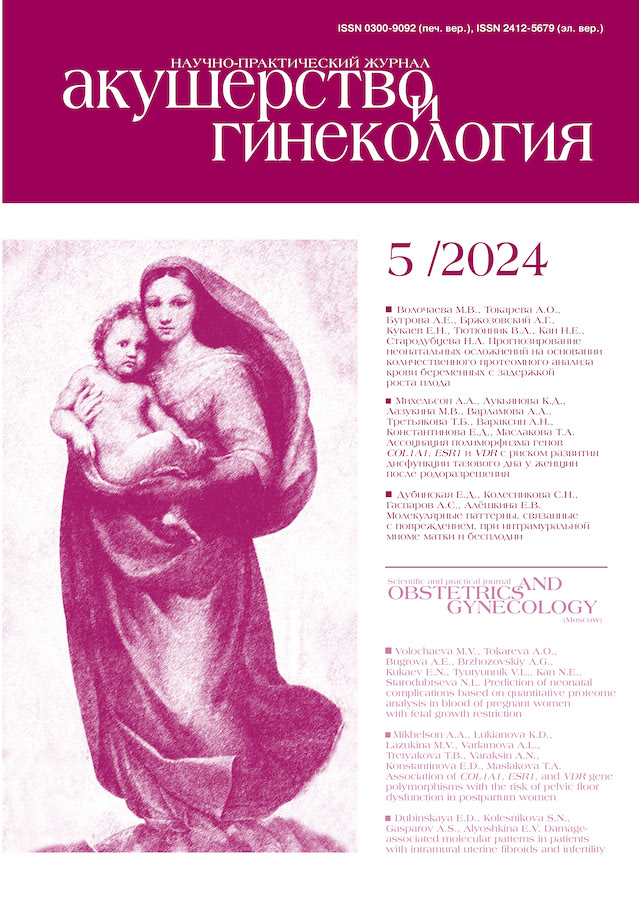Osteogenesis imperfecta and pregnancy
- Authors: Sviridova N.I.1, Tkachenko L.V.1, Verovskaya T.A.2, Skladanovskaya T.V.1, Shumakova N.I.2, Grammatikova O.A.2, Ryabchenko G.A.2, Shklyar A.L.1,2
-
Affiliations:
- Volgograd State Medical University, Ministry of Health of Russia
- Volgograd Regional Clinical Perinatal Center No.2
- Issue: No 5 (2024)
- Pages: 166-170
- Section: Clinical Notes
- Published: 25.06.2024
- URL: https://journals.eco-vector.com/0300-9092/article/view/633765
- DOI: https://doi.org/10.18565/aig.2024.11
- ID: 633765
Cite item
Abstract
Relevance: Osteogenesis imperfecta, or “brittle bone disease”, is a rare inherited disorder with a highly variable spectrum of clinical manifestations. This disease is caused by a primary defect in the protein matrix of bones and connective tissue, which causes their osteopenia. This pathology occurs at a rate of 1 case per 20,000 births among pregnant women. Modern literature describes the cases of successful delivery of women with osteogenesis imperfecta; however, all practitioners note a wide range of complications of the underlying disease during pregnancy, which in some cases require its termination.
Case report: The clinical observation presents the characteristics of the course of pregnancy in a patient with osteogenesis imperfecta and the features of ultrasound diagnosis of this pathology in the fetus.
Conclusion: The described clinical observation of the course of pregnancy in a patient with osteogenesis imperfecta may be of interest to obstetrician-gynecologists when deciding on prolongation or termination of pregnancy. This case can also be of particular relevance to specialists in ultrasound diagnosis and medical genetics when considering possible options for diagnosing the inheritance of the main pathology by the fetus.
Full Text
About the authors
Natalia I. Sviridova
Volgograd State Medical University, Ministry of Health of Russia
Author for correspondence.
Email: n.i.sviridova@yandex.ru
ORCID iD: 0000-0002-3175-4847
Dr. Med. Sci, Head of the Department of Obstetrics and Gynecology, Institute of CMPE
Russian Federation, VolgogradLyudmila V. Tkachenko
Volgograd State Medical University, Ministry of Health of Russia
Email: tkachenko.fuv@mail.ru
ORCID iD: 0000-0002-1935-4277
Dr. Med. Sci, Professor, Professor at the Department of Obstetrics and Gynecology, Institute of CMPE
Russian Federation, VolgogradTatyana A. Verovskaya
Volgograd Regional Clinical Perinatal Center No.2
Email: verovskayata@mail.ru
Chief Physician
Russian Federation, VolgogradTatyana V. Skladanovskaya
Volgograd State Medical University, Ministry of Health of Russia
Email: yanechka2000@yandex.ru
ORCID iD: 0000-0002-1427-610X
Ph.D., Associate Professor at the Department of Obstetrics and Gynecology, Institute of CMPE
Russian Federation, VolgogradNina I. Shumakova
Volgograd Regional Clinical Perinatal Center No.2
Email: shumakova2004@mail.ru
ORCID iD: 0000-0002-5485-6176
Head of the Gynecological Department
Russian Federation, VolgogradOksana A. Grammatikova
Volgograd Regional Clinical Perinatal Center No.2
Email: zav.mgk@vokpc2.ru
Ph.D., Head of Medical and Genetic Consultation
Russian Federation, VolgogradGalina A. Ryabchenko
Volgograd Regional Clinical Perinatal Center No.2
Email: vladimir.musin43@mail.ru
Doctor at the Department of Medical-Genetic Consultation
Russian Federation, VolgogradAlexey L. Shklyar
Volgograd State Medical University, Ministry of Health of Russia; Volgograd Regional Clinical Perinatal Center No.2
Email: vokpc2@yandex.ru
ORCID iD: 0000-0003-3081-2782
Ph.D., Associate Professor at the Department of Obstetrics and Gynecology, Institute of CMPE, Volgograd State Medical University, Ministry of Health of Russia; Deputy Chief Physician, Volgograd Regional Clinical Perinatal Center No. 2
Russian Federation, Volgograd; VolgogradReferences
- Приказ Министерства здравоохранения и социального развития Российской Федерации от 27.12.2011г. №1661н «О внесении изменений в приказ Министерства здравоохранения и социального развития Российской Федерации от 3 декабря 2007 г. № 736 «Об утверждении перечня медицинских показаний для искусственного прерывания беременности». [Order of the Ministry of Health and Social Development of the Russian Federation dated December 27, 2011 No. 1661n “On amendments to the order of the Ministry of Health and Social Development of the Russian Federation dated December 3, 2007 No. 736 “On approval of the list of medical indications for artificial termination of pregnancy”. (in Russian)].
- Приказ Министерства здравоохранения Российской Федерации от 20.10. 2020 г. № 1130н «Об утверждении порядка оказания медицинской помощи по профилю “акушерство и гинекология”». [Order of the Ministry of Health of the Russian Federation dated October 20, 2020 No. 1130n “On approval of the procedure for providing medical care in the field of obstetrics and gynecology”. (in Russian)].
- Мравян С.Р., Шугинин И.О., Новикова С.В., Упрямова E.Ю., Бочарова И.И., Жученко Л.А. Ведение беременности и родов у пациенток с незавершенным остеогенезом. РМЖ. 2015; 20: 1242-5. [Mravyan S.R., Shuginin I.O., Novikova S.V., Upryamova E.Yu., Bocharova I.I., Zhuchenko L.A. Management of pregnancy and childbirth in patients with incomplete osteogenesis. Russian Medical Journal. 2015; (20): 1242-5. (in Russian)].
- Cozzolino M., Perelli F., Maggio L., Coccia M.E., Quaranta M., Gizzo S. et al. Management of osteogenesis imperfecta type I in pregnancy; a review of literature applied to clinical practice. Arch. Gynecol. Obstet. 2016; 293(6): 1153-9. https://dx.doi.org/10.1007/s00404-016-4012-2.
- Ruiter-Ligeti J., Czuzoj-Shulman N., Spence A.R., Tulandi T., Abenhaim H.A. Pregnancy outcomes in women with osteogenesis imperfecta: a retrospective cohort study. J. Perinatol. 2016; 36(10): 828-31. https://dx.doi.org/10.1038/jp.2016.111.
- Lyra T.G., Pinto V.A., Ivo F.A., Nascimento Jdos S. Osteogenesis imperfecta in pregnancy. Case report. Rev. Bras. Anestesiol. 2010; 60(3): 321-4. https://dx.doi.org/10.1016/S0034-7094(10)70040-4.
- Edelu B., Ndu I., Asinobi I., Obu H., Adimora G. Osteogenesis imperfecta: a case report and review of literature. Ann. Med. Health Sci. Res. 2014; 4(Suppl. 1): S1-S5. https://dx.doi.org/10.4103/2141-9248.131683.
- Yimgang D.P., Brizola E., Shapiro J.R. Health outcomes of neonates with osteogenesis imperfecta: a cross-sectional study. J. Matern. Fetal Neonatal Med. 2016; 29(23): 3889-93. https://dx.doi.org/10.3109/14767058.2016.1151870.
- Cubert R., Cheng E.Y., Mack S., Pepin M.G., Byers P.H. Osteogenesis imperfecta: mode of delivery and neonatal outcome. Obstet. Gynecol. 2001; 97(1): 66-9. https://dx.doi.org/10.1016/s0029-7844(00)01100-5.
Supplementary files












